
I have to admit, I’ve been giggling to myself at some of the comments that are popping up on the sites that have covered the Vampire Weekend image controversy. There seems to be confusion in monumental proportions regarding who owns the rights to a picture, to people’s images in a picture, and what you can—or can’t—do with a picture that you own. Confused much? We’ve put together the Small Aperture Quick and Dirty Guide to Photographs, People’s Images, and Rights. Just remember that we’re not lawyers.
Copyright
If you shoot a picture, you own the copyright to it*. No one can reproduce it or otherwise make use of it without your permission.
*) The only exception is if you have explicitly signed away your rights. This might be part of your job contract at work – for example if you are taking photos for work, during work hours. In the UK at least, you can only sign away your copyright in writing, and you have to sign the document where you do so. Ticking a box on a website wouldn’t be sufficient.
Moral rights
You also own the moral rights to pictures that you take. In short, that means that your pictures should be attributed to you, and you can ‘protect their integrity’, or stop people from manipulating and distorting them.
Images of people: commercial, editorial, and personal use
If the picture features a person or people who are easily identifiable, you will require a model release, which is essentially that person’s or people’s consent, to use the picture for commercial purposes. If the picture of a yak farmer leading his herd down the mountain is just going to sit on your Flickr stream as part of your holiday snaps from Outer Mongolia, you don’t have to worry. Sell the picture to the publishers of the Encyclopaedic Guide to Mountain Yak Rearing, you’ll need a model release.
But, there are some exceptions to this. Inevitably.
Caveat number 1: Crowd scenes and itty-bitty people on the horizon whom you can’t make out properly (or similar)
You’re standing amongst the crowd at the London Marathon and you manage to snap the perfect shot of hundreds of spectators standing at Canary Wharf, cheering on the runners. It’s so perfect that Nike wants to use it in a commercial campaign. Do you need model releases from everyone in it? Not if they aren’t recognisable individually (even if someone says ‘But I knew I stood right next to that lamp-post all day’), in this instance it wouldn’t be reasonable.
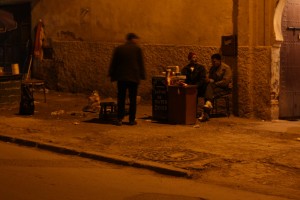
These guys manning a laminating stand (in the middle of the street in Fez, at about 10pm) are probably obscure enough for me to get away with this shot. Probably.
Caveat number 2: Famous people doing famous-people things
It’s pretty much a given that famous people’s pictures taken when they are doing famous-people things, such as tripping the light fantastic up the red carpet at film premieres, opening yet another megalithic shopping centre with a false smile affixed to their faces, or taking an amazing catch at a cricket match, are fair game. But that’s only for personal (i.e. Flickr or your portfolio site) or editorial (i.e. news reporting or reviewing related to the picture) use.
You couldn’t use a photo of Tom Cruise attending a movie premiere to advertise toothpaste—no matter how shiny his teeth are—without a specific model release. And as far as Tom Cruise is concerned – good luck getting one of those.
Caveat number 3: Famous people doing stupid-people things
You’re out having a quiet meal with your best friend when you spot Cruella Manningly-Kneesup, Secretary of State for Juggling, Air Guitar, and Space Cadets locked in a passionate embrace with someone definitely not her husband. In fact, it’s Marco Poloco, whose company was recently awarded the government contract to supply rocket launchers and hover cars to the Space Cadet programme. Hmm. Is something fishy going on? Maybe! Obviously neither of these two is going to give you a model release for the picture that you snap with your ever-handy compact camera, but publishing it would be in the national interest – so you wouldn’t have to worry about privacy or libel too much.
Still the same applies as above: you couldn’t use the same picture of Manningly-Kneesup and Poloco in an advert for birth control. As much as you would like to.
Ownership of rights vs ownership of an artefact
Selling a copy of a picture is different to selling the rights to a picture. I use some of the photos that I take to make greetings cards. Mostly, I make them to send to my friends and family, but every now and then a misguided soul will ask me if they can buy one to send to their great aunt Marjory. I might’ve sold this person a copy of one of my pictures, but that’s it. All they own is the physical artefact, nothing else. They can’t reproduce it or make derivative works from it. Come to think of it, the same goes for the people to whom I give these cards.
Selling rights
Selling the rights to a picture means selling the rights to use a picture. There are different ways of selling the rights to use your pictures, because the number of times it can be used, and how, and where, will be dependent on the contract you agree, and that’s not really for this post. But the simple explanation is that if anyone wants to use a picture that you took, they have to at the very least ask your permission first. Then you can ask them for some money to do so. Okay?
And finally
Remember that you’re allowed to take pictures in UK public places without let or hindrance, and that we’re not solicitors, so all of this is for general guidance only, mkay?








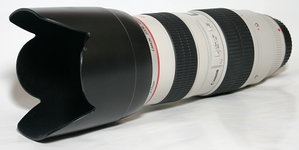
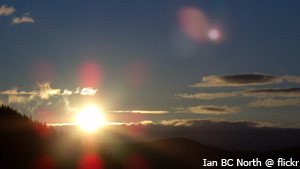
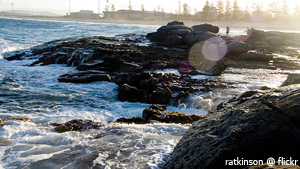 A second way to test for lens flare is what is known as the ‘window test’. Aim the camera someplace indoors, but have a bright window just out of the view of the lens. If your image, upon developing ended up with the tell tale signs of lens flare, you know your camera can’t handle that sort of situation so well.
A second way to test for lens flare is what is known as the ‘window test’. Aim the camera someplace indoors, but have a bright window just out of the view of the lens. If your image, upon developing ended up with the tell tale signs of lens flare, you know your camera can’t handle that sort of situation so well.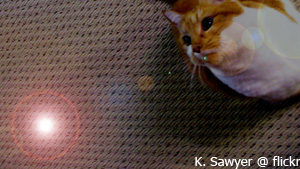 Okay, so I thought we were trying to avoid lens flare. Why would Photoshop come up with something people try to avoid? For the simple fact that lens flare shouldn’t always be avoided. In fact, it can a little something extra to your images when used in the right circumstances.
Okay, so I thought we were trying to avoid lens flare. Why would Photoshop come up with something people try to avoid? For the simple fact that lens flare shouldn’t always be avoided. In fact, it can a little something extra to your images when used in the right circumstances.